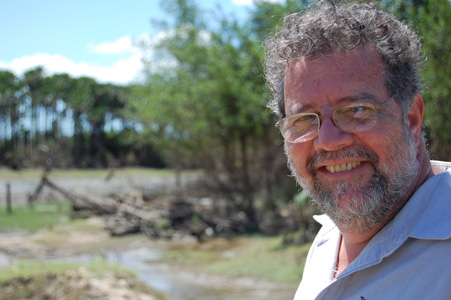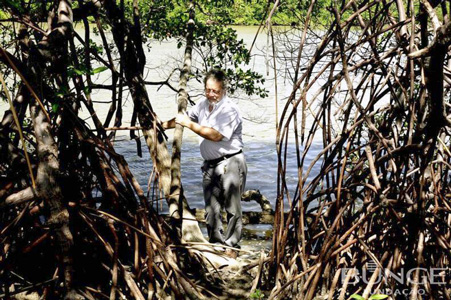 The Amazon basin has a long history of mercury contamination, stemming from the mining industry. Luiz Drude de Lacerda, one of TWAS's 52 recently elected Fellows, works to improve our understanding mercury pollution in the Amazon, and how some plantlife native to the area could be vital allies to containing it.
The Amazon basin has a long history of mercury contamination, stemming from the mining industry. Luiz Drude de Lacerda, one of TWAS's 52 recently elected Fellows, works to improve our understanding mercury pollution in the Amazon, and how some plantlife native to the area could be vital allies to containing it.
“Most of this mercury is from present-day gold mining or past Spanish silver mining,” said Lacerda, a biogeochemist with Universidade Federal do Ceará in Brazil. “They use the mercury to amalgamate the gold, and after that they burn the amalgam to release the mercury, and have your silver or gold that’s pure.” The mercury then goes into the atmosphere, but is brought back to the soil by rainfall. In the topsoil, it sits like a ticking time bomb, activated when erosion sets it loose into the water stream. Erosion is sped up by activities such as deforestation, making the mercury problem worse even where mining no longer takes place.
“All this mercury contamination today is due to changes in the ecosystem rather than a new source of mercury coming into the Amazon,” said Lacerda. “This is important because the Amazon in changing very fast. We’re not sure how much mercury can still be mobilized and when it’s going to reach us, because it would be highly toxic to the local population.”
Lacerda also studies how mangroves – trees and shrubs that grow in tropical swamps – present a natural means to control the mercury problem. Mangroves need very little oxygen, which allows their soils to act like a sponge that absorb metallic contaminants. “It’s a fantastic natural treatment for polluted waters,” said Lacerda. “But only works if you keep the mangroves intact.” If you cut away the mangroves for farming or erecting new buildings, which is common in Brazil, then the molecules in the soil holding the mercury in place break apart and release the heavy metal back into the water and atmosphere."
 “This legacy of contamination that we’ve been building up...can be remobilized by changing the planet surface,” he said.
“This legacy of contamination that we’ve been building up...can be remobilized by changing the planet surface,” he said.
Lacerda said he’s happy to have been elected a TWAS Fellow, because the organization helps raise the prestige of universities in the South and gives him and other scientists in the developing world another chance to make a difference. “In Brazil, when people say, ‘Where did you get your PhD?’, getting it in the Third World is not seen as fancy,” said Lacerda.
“We're all scientists," he added. "We're not doing anything different in Africa, South America and Asia.”
* * *
Every year TWAS elects dozens of scientists who have taken great strides in advancing their chosen fields as TWAS members. Some of them live and work in the developing world and some are researchers in developed countries whose efforts contribute to scientific growth the South. Candidates for membership are nominated and evaluated by established members, and then elected from a short-list each year by panels of members at the TWAS General Meeting.
At the 2013 General Meeting in Buenos Aires, Argentina, they elected 52 new members, raising the total membership to 1,110. Of the new members, 12 are from India, 11 are from Brazil, nine are from China, four are from Taiwan, China, and two are from Vietnam. One each was elected from Australia, Azerbaijan, Benin, Ethiopia, France, Japan, Kenya, Pakistan, South Korea, Tanzania, Thailand, the United Kingdom, the United States and Venezuela. Six of the 52 new members are women. Regionally, 29 are from developing countries in Asia, 11 from Latin America, 3 from Sub-Saharan Africa, and none are from the Arab Region.
- Section 1, Agricultural Sciences: Ricardo Antunes de Azevedo of Brazil; Zeyaur Rahman Khan of India; Papa Abdoulaye Seck of Senegal; and Zhu Yuxian of China.
- Section 2, Structural, Cell and Molecular Biology: Soo-Chen Cheng of Taiwan, China; Takashi Gojobori of Japan; Tao-Shih Hsieh of Taiwan, China; Helena B. Nader of Brazil; and Jayant Udgaonkar of India.
- Section 3, Biological Systems and Organisms: Anwar Gilani of Pakistan; Jitendra Paul Khurana of India; Luiz Drude de Lacerda of Brazil; Lee Sang Yup of Republic of Korea; and Raman Sukumar of India.
- Section 4, Medical and Health Sciences including Neurosciences: Abraham Aseffa of Ethiopia; Mauricio L. Barreto of Brazil; Kathryn Song Eng Cheah of Malaysia; Yuk Ming Dennis Lo of China (winner of TWAS's 2012 Ernesto Illy Trieste Science Prize); Narinder Kumar Mehra of India; and Viswanathan Mohan of India.
- Section 5, Chemical Sciences: Christian Amatore of France; Vanderlan da Silva Bolzani of Brazil; Pratim Kumar Chattaraj of India; Xiao-Ming Chen of China; Song Gao of China; Martyn Poliakoff of the United Kingdom; and He Tian of China.
- Section 6, Engineering Sciences: Ali Abbasov of Azerbaijan; Chennupati Jagadish of Australia; Anurag Kumar of India; Ranjan Kumar Mallik of India; Mei Hong of China; and Bhim Singh of India.
- Section 7, Astronomy, Space and Earth Sciences: Eduardo Luiz Damiani Bica of Brazil; Alexander Wilhelm Armin Kellner of Brazil; Shaw Chen Liu of Taiwan, China; Evelyne Isaack Mbede of Tanzania; David Ruffolo of Thailand; and Sreedharan Krishnakumari Satheesh of India.
- Section 8, Mathematical Sciences: Artur Oscar Lopes of Brazil; Quoc-Khanh Phan of Vietnam; Hoang Xuan Phu of Vietnam; and Ivan Shestakov (Chestakov) of Brazil.
- Section 9, Physics: Nathan Berkovits of Brazil; Adalberto Fazzio of Brazil; Anamaría Font of Venezuela; Shih-Chang Lee of Taiwan, China; Juan Martin Maldacena of the United States; Deepak Mathur of India; and Bao-Gen Shen China.
- Section 10, Social and Economic Sciences: Kaushik Basu of India; and Jikun Huang of China.
– Sean Treacy

